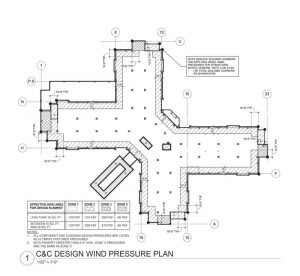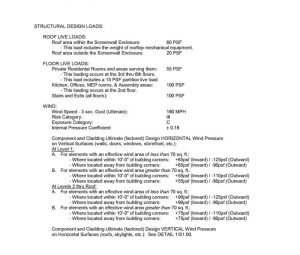Challenge of wind speeds and loads

Coastal areas are associated with hurricane wind speeds but also susceptible to lesser-wind storms and higher-wind tornados, both of which can be devasting to buildings and structures. Structural components, exterior opening protections (windows, doors, louvers), roofing, and exterior cladding need to meet stringent requirements for resistance to these forces. Applicable code items comprising wind design include wind speeds, risk category based upon use and occupancy—ranging from I (low hazard to human life in event of failure) to IV (essential facilities), wind exposure (B, C, and D), applicable internal pressure coefficient, and design wind uplift pressure.
There are two design methods used to determine wind loads: allowable stress design (ASD) and ultimate design (strength design). Winds speeds (V) can then be determined and translated to pressure (P) on the building and/or structure in pounds per square foot. ASD values (Vasd) are obtained from a conversion of the basic wind speeds (V) values.
Wind speed contour maps and roof design zones
The International Building Code (IBC) and the American Society of Civil Engineers ASCE-7 standard (referenced by IBC) both contain Wind Speed Maps and requirements pertaining to wall and roof design zones used to figure pressure and suction wind loads on the structure, affecting structural member spacing, roof/deck thickness, and fastener and seam reinforcement requirements. These wind loads are associated with wind in general, whether from a storm or hurricane event. ASCE does not directly address tornado wind speed design but does include commentary guidance for designing structures and buildings to minimize damage from these events, including a simplified tornado factor (TF) for recommended adjustments to design pressures used for calculations.

Even though listed wind speeds have decreased in most regions of the United States over the last 10 years, it is important for design professionals to know and specify the correct basic wind speed (especially in coastal areas where the contours are closely spaced) and to match it to the correct risk category to ensure competent code compliance and accurate budget, cost, and constructability detailing.
Florida specific: High velocity hurricane zone (HVHZ) and wind-borne debris regions (WBDR)
After CAT-5 Hurricane Andrew hit Florida in 1992, the State enacted new specific Florida Building Codes (FBC) modeled after IBC, including adding a defined high velocity hurricane zone (HVHZ). Today that zone encompasses only Miami-Dade and Broward Counties along the Atlantic Ocean, as well as the Florida Keys. HVHZ have design wind speeds ranging from 251 to 322 km/h (156 to 200 mph) depending on location and risk category of the building. Other areas that are within 1.6 km (1 mi) of the coast where the ultimate design wind speed (UDWS) exceeds 209 km/h (130 mph) or in any areas where the UDWS is greater than 225 km/h (140 mph) are in WBDR.

Hurricane speeds typically published in news reports are categorized by the Saffir-Simpson Hurricane Wind Scale, showing sustained wind speeds. The five categorizations can be found at weather.gov/mfl/saffirsimpson.
It is important to note this scale’s sustained wind speeds are not the same as code required design wind speeds used in the design of building structures and components which are given as three-second gusts, higher than the corresponding sustained winds.




